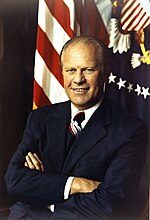United States House elections, 1964
|
|
||||||||||||||||||||||||||||||||||
|---|---|---|---|---|---|---|---|---|---|---|---|---|---|---|---|---|---|---|---|---|---|---|---|---|---|---|---|---|---|---|---|---|---|---|
|
||||||||||||||||||||||||||||||||||
|
All 435 seats to the United States House of Representatives 218 seats were needed for a majority |
||||||||||||||||||||||||||||||||||
|
||||||||||||||||||||||||||||||||||
|
||||||||||||||||||||||||||||||||||
The 1964 United States House of Representatives elections was an election for the United States House of Representatives in 1964 which coincided with the election of President Lyndon Johnson. Johnson's landslide victory over Barry Goldwater allowed his Democratic Party to gain a net of 36 seats from the Republican Party, giving them a two-thirds majority in the House. This is the largest House majority held by either party since 1936. The election also marked the first time since Reconstruction that Republicans made inroads in the deep South. Notable freshmen included future Speaker of the House Tom Foley, future Senator and Secretary of Transportation Brock Adams, future Senators John V. Tunney, John Culver, and William Hathaway, future Governor of Ohio John J. Gilligan, future Secretary of the Army Bo Callaway, future Lieutenant Governor of California Edwin Reinecke, and former Mayor of Dallas Earle Cabell.
...
Wikipedia


